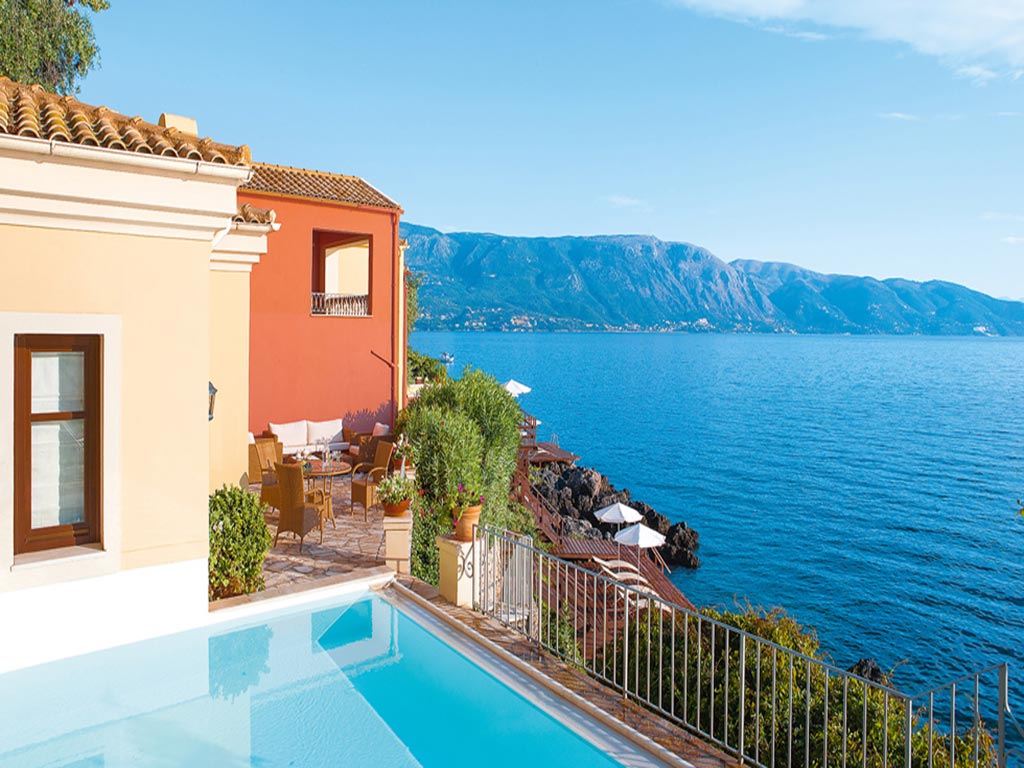The Venetian shipyard built by the Venetians during their rule of Corfu on the west side of what used to be called Govino Bay, the current location of the modern village of Gouvia. The remains of the old arsenal still exist at the Bay of Gouvia, and are located approximately 8 km from Corfu city. The ruins are behind the modern marina of the port of Gouvia and are separated from it by an iron fence.
The Venetians used the bay as a port and their arsenal was built near the water. The Venetian shipyard features three arched docks which were used to service their two fleets which were stationed in Corfu. The columns, walls and arches of the arsenal survive almost intact but the roof is missing.
The arches with Gouvia Bay in the background
The use of the arsenal was officially discontinued when the Treaty of Campo Formio, which was signed on 18 October 1798, signalled the end of the Venetian Republic. Admiral Ushakov landed his troops at the site of the arsenal and created a military camp there during the Siege of Corfu in 1798. The arsenal also functioned as a base for the French in 1917–1918.
Historical background
Located near the mouth of the Adriatic Sea, Corfu was a very strategic location for Venice and the Venetians built extensive fortifications to defend the island against incursions. The island was also at the centre of their naval operations in the Levant. As part of their defence plans the Venetians stationed two squadrons in Corfu, one of twenty five galleys, the other of twelve heavy sailing ships. Two Venetian Vice Admirals oversaw the naval operations in Corfu, one for each squadron.
The rear wall of the shipyard
In the aftermath of the second great siege of Corfu by the Ottomans in 1716, the Venetians, as part of their reinforcement of the fortifications of Corfu, built the arsenal to service their ships and also stationed their galleys at Govino Bay. The arsenal was also used as storage for the Venetian ships.
The shipyard at Gouvia was part of a network of Venetian arsenals and naval stations in Greece, including shipyards in the Aegean Sea, Epirus, the Peloponnese, the Kingdom of Candia (modern Crete) and even Venice itself. Aside from Corfu, such locations in Greece included Methoni, Koroni, Chalkis, Preveza, Chania and Heraklion.
The Venetians built the Gouvia arsenal in a strategic location well-suited to ship repairs as it was near a forested area and high quality wood was plentiful and easily available for ship maintenance.
The keystone of the gateway to the shipyard carries the inscription "ZBM ANNO MDCCLXXVlll" where "ZBM" are probably the initials of one of the ship captains who constructed the arsenal.
The keystone of the gate at the entrance to the shipyard bears the inscription:
ZBM
ANNO
MDCCL
XXVlll
where "ZBM" are probably the initials of one of the ship captains who constructed the arsenal and added their coat of arms and initials to the buildings, and the year is 1778.
The practice of the Venetian captains, who participated in the construction of the arsenal, to inscribe the buildings with their initials and coats of arms, had been documented in the late 18th century writings of French consul to Corfu Saint-Sauveur.
The arsenal at Gouvia was supposed to be used for ship repairs during the winter after each fleet had returned from their yearly campaign during peacetime.
However, the Venetian Senate became alarmed at the prospect of an arsenal in proximity to Venice which could potentially compete with the central arsenal and in order to protect the operations of their local naval facilities, the Senate opted to limit the kind of repair activities undertaken at the Corfu shipyard.
Consequently the shipyard operations at Gouvia were restricted to basic maintenance such as cleaning and caulking; many captains, instead of repairing their damaged ships at the arsenal, chose to sink them.
The arches of the docks
As time went on, the number of ships being serviced at the location declined, and any further use was officially discontinued with the Treaty of Campo Formio, which was signed on 18 October 1798, marking the end of the Venetian Republic and with it the end of the Venetian period of Corfu, which had lasted for over 400 years.
The surviving arches of the structure have been described as "beautifully boned", "strong" and "impressive", "almost surreal", and "a striking collection of skeletal arches".
source: wikipedia















 Corfu Cafe Bars
Corfu Cafe Bars

 Corfu Clubs
Corfu Clubs

 Corfu Restaurants
Corfu Restaurants


 Corfu Boat Rentals
Corfu Boat Rentals

 Corfu Hotels
Corfu Hotels













